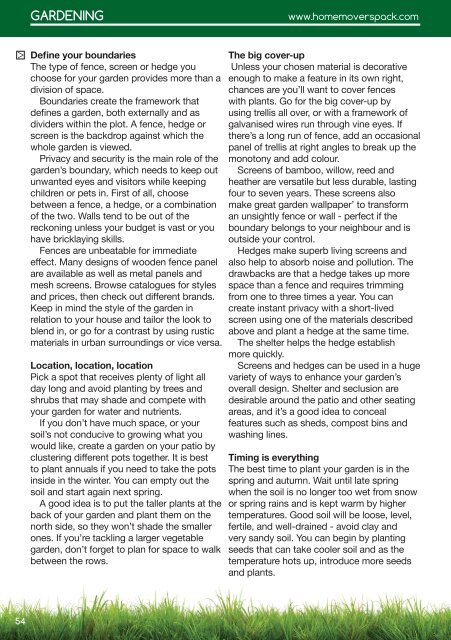home movers pack 2017
You also want an ePaper? Increase the reach of your titles
YUMPU automatically turns print PDFs into web optimized ePapers that Google loves.
GARDENING<br />
www.<strong>home</strong><strong>movers</strong><strong>pack</strong>.com<br />
><br />
Define your boundaries<br />
The type of fence, screen or hedge you<br />
choose for your garden provides more than a<br />
division of space.<br />
Boundaries create the framework that<br />
defines a garden, both externally and as<br />
dividers within the plot. A fence, hedge or<br />
screen is the backdrop against which the<br />
whole garden is viewed.<br />
Privacy and security is the main role of the<br />
garden’s boundary, which needs to keep out<br />
unwanted eyes and visitors while keeping<br />
children or pets in. First of all, choose<br />
between a fence, a hedge, or a combination<br />
of the two. Walls tend to be out of the<br />
reckoning unless your budget is vast or you<br />
have bricklaying skills.<br />
Fences are unbeatable for immediate<br />
effect. Many designs of wooden fence panel<br />
are available as well as metal panels and<br />
mesh screens. Browse catalogues for styles<br />
and prices, then check out different brands.<br />
Keep in mind the style of the garden in<br />
relation to your house and tailor the look to<br />
blend in, or go for a contrast by using rustic<br />
materials in urban surroundings or vice versa.<br />
Location, location, location<br />
Pick a spot that receives plenty of light all<br />
day long and avoid planting by trees and<br />
shrubs that may shade and compete with<br />
your garden for water and nutrients.<br />
If you don’t have much space, or your<br />
soil’s not conducive to growing what you<br />
would like, create a garden on your patio by<br />
clustering different pots together. It is best<br />
to plant annuals if you need to take the pots<br />
inside in the winter. You can empty out the<br />
soil and start again next spring.<br />
A good idea is to put the taller plants at the<br />
back of your garden and plant them on the<br />
north side, so they won’t shade the smaller<br />
ones. If you’re tackling a larger vegetable<br />
garden, don’t forget to plan for space to walk<br />
between the rows.<br />
The big cover-up<br />
Unless your chosen material is decorative<br />
enough to make a feature in its own right,<br />
chances are you’ll want to cover fences<br />
with plants. Go for the big cover-up by<br />
using trellis all over, or with a framework of<br />
galvanised wires run through vine eyes. If<br />
there’s a long run of fence, add an occasional<br />
panel of trellis at right angles to break up the<br />
monotony and add colour.<br />
Screens of bamboo, willow, reed and<br />
heather are versatile but less durable, lasting<br />
four to seven years. These screens also<br />
make great garden wallpaper’ to transform<br />
an unsightly fence or wall - perfect if the<br />
boundary belongs to your neighbour and is<br />
outside your control.<br />
Hedges make superb living screens and<br />
also help to absorb noise and pollution. The<br />
drawbacks are that a hedge takes up more<br />
space than a fence and requires trimming<br />
from one to three times a year. You can<br />
create instant privacy with a short-lived<br />
screen using one of the materials described<br />
above and plant a hedge at the same time.<br />
The shelter helps the hedge establish<br />
more quickly.<br />
Screens and hedges can be used in a huge<br />
variety of ways to enhance your garden’s<br />
overall design. Shelter and seclusion are<br />
desirable around the patio and other seating<br />
areas, and it’s a good idea to conceal<br />
features such as sheds, compost bins and<br />
washing lines.<br />
Timing is everything<br />
The best time to plant your garden is in the<br />
spring and autumn. Wait until late spring<br />
when the soil is no longer too wet from snow<br />
or spring rains and is kept warm by higher<br />
temperatures. Good soil will be loose, level,<br />
fertile, and well-drained - avoid clay and<br />
very sandy soil. You can begin by planting<br />
seeds that can take cooler soil and as the<br />
temperature hots up, introduce more seeds<br />
and plants.<br />
54













